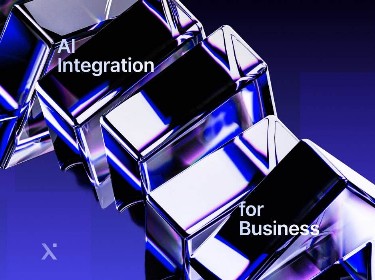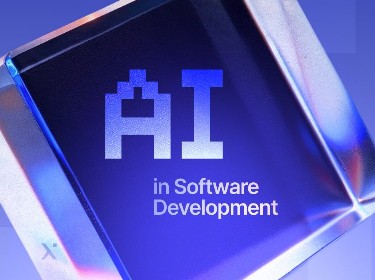Ever wondered how Netflix knows exactly what you want to watch next? Or how your bank can spot a fraudulent transaction in the blink of an eye? The magic behind these abilities is the powerful AI models that drive them.
Here at PixelPlex, we’re active participants of AI technology development. Our team of experts has been at the forefront of the AI wave, building and deploying cool AI solutions for a diverse range of clients. We’ve seen firsthand the power of AI, and we believe that with the right knowledge, you too can use its potential.
The growth of AI is staggering. Did you know the global AI market size was valued at USD 196.63 billion in 2023 and is projected to grow at a compound annual growth rate (CAGR) of 36.6% from 2024 to 2030? This is a fundamental change in how businesses operate nowadays.
That’s why we’ve put together this comprehensive guide on how to create an AI model. We’ll take you on a journey from the initial spark of an idea to the final, deployed model, breaking down each step into simple, easy-to-understand terms. Get comfortable, and let’s dive into the fascinating world of AI model development.
What exactly is an AI model?
Before we get our hands dirty with the “how,” let’s take a moment to understand the “what.” In the simplest terms, an AI model is a computer program that has been trained to recognize certain types of patterns. We can call it a digital brain that you can teach to perform specific tasks.
This “teaching” process is called training, and it involves feeding the model vast amounts of data. The model learns from this data, identifying patterns and relationships that it can then use to make predictions or decisions about new, unseen data.
For example, if you want to create an AI model that can identify pictures of cats, you would train it on a massive dataset of images, some of which are labeled “cat” and some of which are not. The model would learn to recognize the specific features that make up a cat – pointy ears, whiskers, a long tail, and so on. Once trained, the model could then look at a new picture and tell you with a high degree of accuracy whether or not it contains a cat.
![]()
This is a simple example, but the same basic principles apply to more complex tasks, like predicting stock prices, diagnosing diseases, or even composing music. The key is to have the right data and to choose the right type of model for the job.
AI Chatbots in Banking: Overview
AI for Project Management: Everything You Need To Know
Chatbots in Healthcare: New Wave of AI
Step 1: Defining the problem and goal
![]()
The very first step in creating an AI model is to clearly define the problem you’re trying to solve. This might seem obvious, but it’s a crucial step that is often overlooked. Without a clear understanding of the problem, you’ll be shooting in the dark, and your project is likely to fail.
Ask yourself:
- What is the specific problem I want to solve? Is it to predict customer churn? To detect fraudulent transactions? To automate a manual process?
- What is the desired outcome? What do I want the AI model to do? What will success look like?
- What data do I have available? Is it relevant to the problem? Is it clean and well-structured?
Let’s say you’re a retail company and you want to reduce customer churn. Your problem is that you’re losing too many customers. Your desired outcome is to identify customers who are at risk of churning so that you can proactively offer them incentives to stay. The data you have available might include customer demographics, purchase history, and website activity.
By clearly defining the problem and the goal, you’ll have a roadmap to guide you through the rest of the process of how to make an AI model. It will also help you to choose the right type of AI model for the job.
Step 2: Data collection and preparation
Data is the lifeblood of any AI model. Without high-quality, relevant data, even the most sophisticated model will fail to perform. This is why data collection and preparation is one of the most important and time-consuming steps in the process of how to build an AI model.
In fact, data preparation and collection often consume 60-80% of an AI project’s timeline. It’s not the most glamorous part, but it’s utterly essential.
Data collection
The first step is to gather the data you’ll need to train your model. This data can come from a variety of sources, such as:
- Internal databases: Your company’s own databases are often a rich source of data. This might include customer data, sales data, or operational data.
- Public datasets: There are many public datasets available that you can use for your project. These datasets are often curated and cleaned, which can save you a lot of time and effort.
- Third-party data providers: You can also purchase data from third-party providers. This can be a good option if you need a specific type of data that is not readily available.
- Web scraping: In some cases, you may need to scrape data from websites. This can be a complex process, but it can be a good way to get the data you need.
Once you’ve collected your data, you’ll need to prepare it for training. This is a critical step, as the quality of your data will have a direct impact on the performance of your model.
Data preparation
Data preparation, also known as data preprocessing, involves cleaning, transforming, and formatting your data so that it’s ready for training. This can involve a number of tasks, such as:
- Handling missing values: Your dataset may have missing values, which can cause problems during training. You’ll need to decide how to handle these missing values, such as by removing the rows with missing values or by imputing the missing values with the mean or median.
- Removing duplicates: Your dataset may also contain duplicate rows, which can bias your model. You’ll need to identify and remove these duplicates.
- Handling outliers: Outliers are data points that are significantly different from the other data points in your dataset. These outliers can also bias your model, so you’ll need to decide how to handle them.
- Feature engineering: Feature engineering is the process of creating new features from your existing data. This can be a great way to improve the performance of your model. For example, if you have a dataset of customer purchase history, you could create a new feature that represents the average purchase amount for each customer.
- Data formatting: Finally, you’ll need to format your data so that it’s in the right format for your chosen AI model. This might involve converting categorical variables into numerical variables or scaling your data so that it’s all on the same scale.
Data preparation is a complex and iterative process, but it’s essential for creating an AI model that is accurate and reliable. Ignoring this stage is like trying to build a skyscraper on a sandy foundation – it’s bound to cause problems down the line!
Step 3: Choosing the right AI model
Now that you’ve prepared your data, it’s time to choose the right AI model for the job. There are many different types of AI models to choose from, each with its own strengths and weaknesses. The best model for your project will depend on the specific problem you’re trying to solve and the type of data you have.
Here are some of the most common types of AI models:
- Linear regression: This is one of the simplest types of AI models, and it’s used for predicting a continuous value. For example, you could use a linear regression model to predict the price of a house based on its size and location.
- Logistic regression: This type of model is used for classification tasks, where the goal is to predict a categorical value. For example, you could use a logistic regression model to predict whether a customer will churn or not.
- Decision trees: Decision trees are a type of model that uses a tree-like structure to make decisions. They are easy to understand and interpret, which makes them a good choice for many projects.
- Random forests: Random forests are an ensemble learning method that combines multiple decision trees to improve the accuracy of the predictions.
- Support Vector Machines (SVMs): SVMs are a powerful type of model that can be used for both classification and regression tasks.
- Neural networks: Neural networks are a type of model that is inspired by the human brain. They are very powerful and can be used for a wide range of tasks, such as image recognition, natural language processing, and speech recognition. Our AI development services can help you choose and implement the right neural network architecture for your needs.
![]()
When choosing a model, it’s important to consider the trade-off between accuracy and interpretability. Some models, like neural networks, are very accurate but can be difficult to interpret. Other models, like decision trees, are less accurate but are much easier to understand. The choice often depends on your specific needs and regulatory requirements. For instance, in sensitive domains like finance, transparency is often paramount.
Worthy AI Business Ideas for Your Enterprise
AI in Transportation: How The Industry Grows
Step 4: Training the AI model
Once you’ve chosen your model, it’s time to train it. This is the process of feeding your data to the model and allowing it to learn the patterns and relationships in the data.
The training process in enterprise AI development services typically involves the following steps:
- Splitting the data: The first step is to split your data into two sets: a training set and a testing set. The training set is used to train the model, and the testing set is used to evaluate the performance of the model. A common split is 80% for training and 20% for testing.
- Initializing the model: Next, you’ll need to initialize your model. This involves setting the initial values of the model’s parameters.
- Training the model: Now it’s time to train the model. This is an iterative process where the model is repeatedly shown the training data and its parameters are adjusted to minimize the error.
- Evaluating the model: Once the model has been trained, you’ll need to evaluate its performance on the testing set. This will give you an idea of how well the model will perform on new, unseen data.
The training process can be computationally expensive, especially for large datasets and complex models. You may need to use specialized hardware, such as GPUs, to speed up the training process. For example, training a complex deep learning model can take days or even weeks on standard CPUs, but only hours on powerful GPUs. This is where our expertise in machine learning consulting can be a game-changer, helping you optimize your training infrastructure and processes.
Step 5: Evaluating the model
After training your model, the next crucial step in how to create an AI model is evaluation. You need to know how well your model is performing and whether it’s actually solving the problem you set out to solve. This is where a variety of evaluation metrics come into play.
The specific metrics you use will depend on the type of problem you’re solving:
For regression problems (predicting a continuous value)
You might use metrics like:
- Mean Absolute Error (MAE): The average of the absolute differences between the predicted and actual values.
- Mean Squared Error (MSE): The average of the squared differences between the predicted and actual values.
- R-squared: A statistical measure of how close the data are to the fitted regression line.
For classification problems (predicting a category)
You’ll use metrics like:
- Accuracy: The percentage of correct predictions.
- Precision: The proportion of positive predictions that were actually correct.
- Recall: The proportion of actual positives that were correctly identified.
- F1-score: The harmonic mean of precision and recall, providing a single score that balances both.
- Confusion Matrix: A table that visualizes the performance of a classification model, showing the number of true positives, true negatives, false positives, and false negatives.
It’s important to choose the right evaluation metrics for your specific problem. For example, in a medical diagnosis task, recall is often more important than precision, as you want to minimize the number of false negatives (i.e., you don’t want to miss a patient who actually has the disease). Our experience in business intelligence solutions ensures that the models we build are evaluated against metrics that truly matter to your business.
Check out our recent case: digital twin-powered smart warehouse automation system for a big retailer
Step 6: Parameter tuning
Once you have an initial model and have evaluated its performance, you can often improve it further through parameter tuning, also known as hyperparameter optimization.
Hyperparameters are the settings of the model that are not learned from the data but are set by the developer before the training process begins. For example, the learning rate in a neural network or the number of trees in a random forest are hyperparameters.
The goal of parameter tuning is to find the combination of hyperparameters that results in the best model performance. This can be a complex and time-consuming process, as there can be many different hyperparameters to tune and many different possible values for each hyperparameter.
Consider this: a typical deep learning model might have dozens of hyperparameters, and exploring every combination can quickly become computationally infeasible.
There are several techniques for parameter tuning, including:
- Grid Search: This involves trying all possible combinations of a predefined set of hyperparameter values.
- Random Search: This involves randomly sampling a certain number of combinations from a given distribution of hyperparameter values.
- Bayesian Optimization: This is a more sophisticated technique that uses a probabilistic model to guide the search for the optimal hyperparameters, often finding better solutions with fewer trials.
Parameter tuning is an essential step in how to make an AI model and can often lead to a significant improvement in model performance. Studies show that well-tuned models can achieve 10-15% higher accuracy compared to models with default hyperparameters. It’s a bit like fine-tuning a racing car – small adjustments can make a huge difference to performance.
Step 7: Deployment and monitoring
Once you’re satisfied with the performance of your model, it’s time to deploy it into a production environment so that it can start making predictions on real-world data.
Deployment can be a complex process, and there are many different ways to do it. Some common deployment strategies include:
- As a REST API: This is a popular option, as it allows other applications to easily interact with your model.
- As a batch process: This involves running your model on a schedule to make predictions on a large batch of data.
- On the edge: This involves deploying your model directly onto a device, such as a smartphone or a sensor. This can be a good option for applications that require low latency or that need to work offline.
After deploying your model, it’s important to monitor its performance over time. This is because the performance of your model can degrade over time as the data it’s seeing in production starts to differ from the data it was trained on. This is known as model drift. Ignoring model drift can lead to a significant drop in predictive accuracy, potentially costing businesses millions. For instance, an AI model designed to predict customer behavior might become less accurate if economic conditions drastically change after deployment.
To monitor your model, you’ll need to track its performance on a variety of metrics. If you notice a drop in performance, you may need to retrain your model on new data. Our data security services and security audit and risk management ensure that your deployed models are not only performant but also secure and resilient against malicious attacks.
Check out top 12 data analytics tools that will make your life easier →
AI model development and training tools
You wouldn’t try to build a house with just a hammer, right? Similarly, in the world of AI, developers rely on a powerful suite of frameworks, libraries, and platforms to bring their models to life. These tools streamline the process, handle the heavy lifting of complex mathematics, and ultimately let you focus on solving the actual problem.
Let’s take a peek inside the AI developer’s toolbox and look at some of the most popular and powerful tools out there.
TensorFlow
Developed by the minds at Google, TensorFlow is the heavy-duty power tool of the AI world. It’s a comprehensive, end-to-end platform with a massive ecosystem. It’s incredibly powerful for building and deploying large-scale neural networks and can handle almost any AI task you throw at it. While it has a reputation for being a bit steep to learn, its robustness and scalability make it a top choice for production-grade applications.
PyTorch
This is TensorFlow’s biggest rival, brought to you by Meta (formerly Facebook). PyTorch has won the hearts of many researchers and developers because it feels more intuitive and “Pythonic.” It offers a more flexible and dynamic approach to building models, which is fantastic for experimentation and rapid prototyping. It’s a versatile, high-end multi-tool that’s a joy to work with, especially when you’re exploring new ideas.
Keras
If TensorFlow is the professional-grade power tool, Keras is the wonderfully designed, user-friendly interface that makes it easy for anyone to use. Keras is essentially a high-level API that runs on top of TensorFlow (and other backends). It simplifies the process of building neural networks down to a few lines of code, abstracting away much of the complexity. It’s the perfect starting point for beginners and a great tool for fast development.
Scikit-learn
This is the undisputed Swiss Army knife for traditional machine learning. While TensorFlow and PyTorch are the champions of deep learning, Scikit-learn is the go-to library for almost everything else. From regression and classification to clustering and dimensionality reduction, it provides simple, efficient tools for data mining and data analysis. Its clean, consistent API and excellent documentation make it an essential tool for any data scientist.
Amazon SageMaker, Google Cloud AI Platform, and Microsoft Azure Machine Learning
These three are the big players in the cloud AI space. They are fully-managed, end-to-end platforms. This is your workshop that comes with every tool you could possibly need, all neatly organized and ready to go. They help you with everything from data labeling and model training to one-click deployment and monitoring.
- Amazon SageMaker is deeply integrated into the vast AWS ecosystem.
- Google Cloud AI Platform is known for its cutting-edge AI services, like AutoML.
- Microsoft Azure Machine Learning is praised for its user-friendly, drag-and-drop interface and strong enterprise support.
Hugging Face
This platform has become an absolute game-changer, especially in the field of Natural Language Processing (NLP). Hugging Face is less of a single tool and more of a collaborative hub, like a GitHub for the AI community. Its library provides easy access to thousands of pre-trained models (like BERT and GPT-2) that you can download and fine-tune for your specific task in just a few lines of code. It has democratized access to state-of-the-art AI, saving developers countless hours of training time and resources.
Choosing the right tool often depends on your specific project, your team’s expertise, and your long-term goals. But with such a rich and diverse ecosystem, there’s never been a better time to start building.
| Tool | Good for | Who it’s for |
| TensorFlow | Building and using complex AI models on a very large scale. | Professionals and big companies. |
| PyTorch | Creating new and experimental AI models quickly and easily. | Researchers and people exploring new ideas. |
| Keras | A simple way to build AI models without getting into the complex details. | Beginners and people who want to build things fast. |
| Scikit-learn | Doing classic data analysis and machine learning tasks like sorting data or finding patterns. | Data scientists and anyone doing basic machine learning. |
| Cloud Platforms (SageMaker, Google AI, Azure ML) | A complete “workshop” in the cloud with all the tools you need for every step of an AI project, from start to finish. | Companies and teams who need a complete, all-in-one solution. |
| Hugging Face | Using and sharing ready-made AI models, especially for understanding language. It’s like a library of AI brains you can borrow. | Anyone working with language-based AI who wants to save time and resources. |
Real-world examples of AI models in action
The process of how to create an AI model may seem abstract, so let’s look at a few real-world examples to bring it to life:
Finance
In the world of finance, AI models are used for a variety of tasks, such as fraud detection, credit scoring, and algorithmic trading. For example, a bank might use a machine learning for fraud detection model to identify fraudulent transactions in real-time. This is a core competency we’ve developed through our banking software development services. AI-powered fraud detection systems can reduce false positives by up to 50% and detect new fraud patterns 2-3 times faster than traditional methods.
Healthcare
In healthcare, AI models are used to diagnose diseases, develop new drugs, and personalize treatment plans. For example, a hospital might use an AI model to analyze medical images and identify signs of cancer. The use of AI in drug discovery alone is projected to save billions, with some estimates suggesting it could reduce drug development costs by 25-50%.
Retail
In retail software development, AI models are used for a variety of tasks, such as product recommendations, demand forecasting, and customer segmentation. For example, an e-commerce company might use an AI model to recommend products to customers based on their browsing history. Personalized recommendations driven by AI account for 35% of Amazon’s revenue.
Manufacturing
In manufacturing, AI models are used for predictive maintenance, quality control, and supply chain optimization. For example, a factory might use an AI model to predict when a machine is likely to fail so that it can be repaired before it breaks down.
These are just a few examples of the many ways that AI models are being used to solve real-world problems. As the field of AI continues to evolve, we can expect to see even more innovative applications of AI in the years to come.
The field of AI is constantly evolving, and new techniques and technologies are emerging all the time. One of the most exciting recent developments is the rise of generative AI development and Large Language Models (LLMs) like GPT-3. These models are capable of generating human-like text, translating languages, writing different kinds of creative content, and answering your questions in an informative way.
Another exciting trend is the development of AI copilots, which are AI-powered assistants that can help users with a variety of tasks. For example, a developer might use an AI copilot to help them write code, or a writer might use an AI copilot to help them with their writing. Our AI copilot development services can help you build these powerful tools for your own business.
As we look to the future, we can expect to see even more powerful and sophisticated AI models that are capable of solving even more complex problems.
Conclusion
The journey of how to create an AI model is a complex but rewarding one. It requires a deep understanding of data, algorithms, and business needs. From defining the problem to deploying and monitoring the model, each step is crucial for success.
![]()
At PixelPlex, we’re passionate about helping businesses like yours navigate this journey. Our team of experienced blockchain and AI developers has the skills and expertise to help you build and deploy powerful AI solutions that drive real business value. Whether you’re just starting to explore the possibilities of AI or you’re ready to build a custom AI model development from scratch, we’re here to help.
We’ve covered a lot in this guide, but this is just the tip of the iceberg. The world of AI is vast and constantly evolving, and we’re committed to staying at the forefront of this exciting field. If you’re ready to take the next step and start building your own AI models, we encourage you to get in touch with our team. We’d love to hear about your project and discuss how we can help you turn your vision into a reality. We hope this guide on how to make an AI model has been helpful, and we look forward to our cooperation – drop us a line here.
FAQ
An AI model is a computer program that’s been trained to recognize patterns and make smart decisions. To create one, you start by defining the problem you want to solve, then you collect and prepare the right data. After that, you choose the best type of AI model for the job, train it using your data, and then fine-tune and test it to make sure it’s accurate and ready to go.
Data is the fuel for an AI model. Without a large amount of high-quality, relevant data, the model can’t learn effectively. Think of it like teaching a student: if you only give them a few low-quality textbooks, they won’t learn much. It’s the same with AI. The better your data, the smarter your model will be.
The process can be broken down into seven key steps: 1) Clearly define the problem you’re trying to solve. 2) Collect and prepare your data, which is a big and important step. 3) Choose the right type of AI model for your project. 4) Train your model using your data. 5) Evaluate its performance to make sure it’s working well. 6) Fine-tune its settings to get the best results. 7) Finally, put the model to work in your business and keep an eye on it.
The right model depends entirely on what you want to achieve. For example, if you want to predict a continuous value like sales, you might use a Linear Regression model. If you want to sort customers into groups, you’d use a classification model. The most powerful models, called Neural Networks, are great for complex tasks like image recognition or understanding language.
After you create an AI model and launch it, it’s crucial to monitor its performance. Over time, the real-world data it’s analyzing might change, causing the model to become less accurate. This is called model drift. To prevent this, you need to track its performance and, if you see it slipping, retrain it with fresh, new data.




